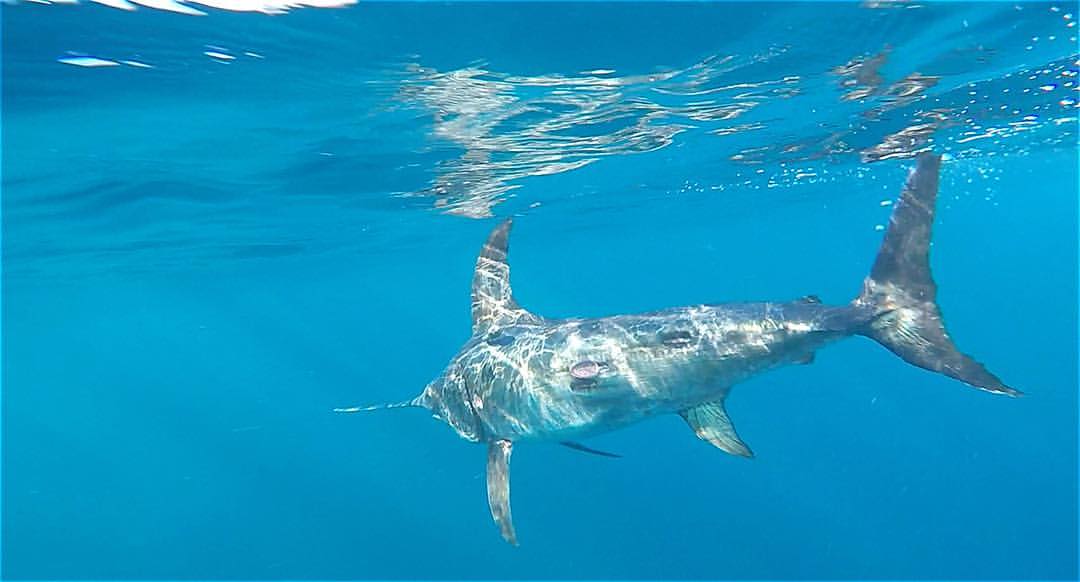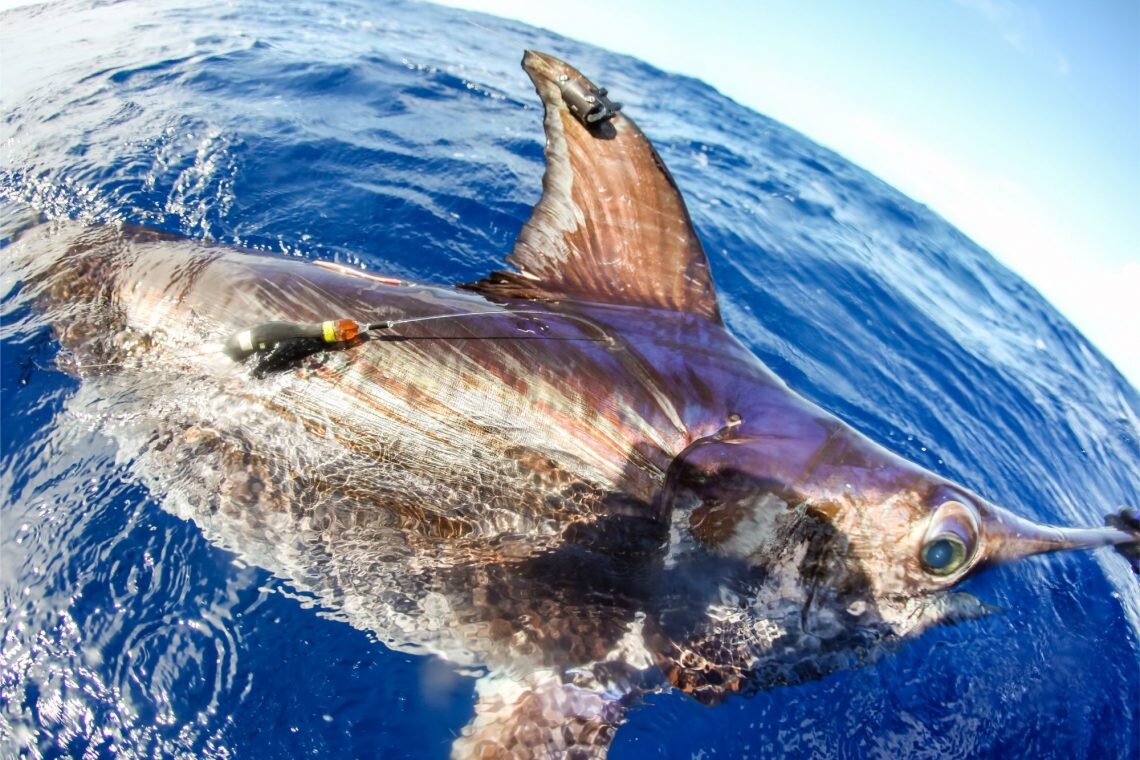About the project
This Great Swordfish Race Project aims to provide data on this exciting new fishery, including information on the timing and availability of swordfish in Eastern Australian waters, whether swords return to the same grounds seasonally and their suitability for catch and release.
This research will help us to learn more about the recreational swordfish fishery in NSW to maximise its potential while ensuring the longevity of the fishery is maintained.
DPI is undertaking the project with the Australian National Sportfishing Association (NSW) and the NSW Game Fishing Association. A small team of NSW-based game and sportfishing swordfish experts will be provided with the sat tags to enable the collection of data.
Data from this project will be used as part of a larger swordfish project being undertaken by Dr Sean Tracey of the Institute for Marine and Antarctic Studies in Hobart, with similar objectives completed in Tasmania and currently underway in Victoria.
We’ll keep you updated with this exciting project as news becomes available.
The Great Swordfish Race is another example of NSW recreational fishing licence fees at work!
About swordfish
Swordfish, also known as broadbills, are large, migratory, predatory fish with a long, flat bill. Their scientific name is Xiphias gladius. They are the sole member of their family, Xiphiidae. They are similar to some other billfish such as marlin but in fact are from different families.
These elusive recreational sport fish are found in the Atlantic, Pacific, and Indian Oceans, either near the surface to a depth of about 550 metres. They grow to about 4.5 metres in length, and to a weight of about 650 kg. Pacific swordfish are generally bigger than northwest Atlantic and Mediterranean swordfish. The International Game Fish Association's all-tackle angling record for a swordfish was a 536 kg fish taken off Chile in 1953.
Tiny otoliths from an enormous swordfish.
Females are larger than males. They live to about 15 years. Swordfish ages are often derived from annual rings on fin rays rather than otoliths, since their otoliths are incredibly small in size.
Swordfish are ectothermic— i.e. their internal physiological sources of heat are not importance in controlling body temperature; however, (like some sharks,) they have special organs next to their eyes to heat their eyes and brains, which greatly improves their vision.
Broadbill swordfish have long, cylindrical bodies that fade from blackish-brown on the back and sides to light brown on the underside. The membrane of the first dorsal fin is usually black. Adults lack scales, teeth and pelvic fins. Their "sword" is not used to spear, but instead may be used to slash and injure their prey. They are among the fastest of all fish and are not schooling fish, they swim alone or in very loose aggregations.
They are highly migratory species and travel to colder regions to feed during the summer. They are primarily a warm-water species that moves into cooler, temperate waters for feeding during the Australian summer months and returns to warmer tropical waters for spawning and over-wintering. Swordfish feed mostly at night, when they rise to surface and near-surface waters in search of smaller feeding on a wide range of pelagic fish, but they also take demersal fish, squid, and crustaceans.
They are frequently found basking at the surface, airing their first dorsal fin.
Adults have few natural predators apart from orcas and large sharks, juvenile swordfish are more vulnerable to predation by tuna, marlin, sailfish and sharks.
Reproduction
Spawning mainly occurs in water warmer than 23 °C. In some parts of the world this is during spring and summer, but is year-round in very warm regions.
Juveniles already show the bill forming when only 10 mm long.
Broadbill swordfish reach reproductive maturity at 5-6 years old (although research in 2004 suggested that maturity may not occur until 10 years of age). Females are serial spawners and release eggs up to 90 times at intervals of about 2.5 days during the spawning season. Females produce 1.2‑2.5 million eggs per spawning event depending on their body size. Large females carry more eggs than small females, up to 29 million eggs have been recorded. The eggs measure 1.6–1.8 mm in diameter and 2.5 days after fertilization, the embryonic development occurs. The surface-living and unique-looking larvae are 4 mm long at hatching and the bill is already evident by the time the larvae reach 1 cm.
Game fishing
Swordfish are one of the most prized catches of game fishers.
The most common method is deep-drop fishing, since swordfish spend most daylight hours very deep. The boat is allowed to drift to present a more natural bait at depths of up to 500 metres. Night fishing usually occurs at much shallower depths, often less than 90 metres. Standard baits are whole fish and live bait, imitation squid and lures are also used.
Commercial fishing
Swordfish are targeted by fishers in both the Eastern Tuna and Billfish Fishery and the Western Tuna and Billfish Fishery. Fishers use pelagic longline gear to catch swordfish. These longlines hang in the water column and do not touch the seafloor. The Australian Fisheries Management Authority (AFMA) manages catches of swordfish with a total allowable catch limit. This restricts the weight of fish that can be caught by each commercial fisher. Commercial fishers are required to fill in records of their catches, during each fishing trip and when they land their catch in a port. AFMA also restricts the type of gear that can be used to fish for swordfish.
As swordfish are caught by many other countries in the western and central Pacific Ocean and the Indian Ocean, this species is also managed internationally. The Western and Central Pacific Fisheries Commission and the Indian Ocean Tuna Commission are the international bodies responsible for managing the world’s tropical tuna and billfish catch in the Western Pacific Ocean and the Indian Ocean. Australia is a participating member of both Commissions and AFMA has to follow the decisions made by both these Commissions when managing the Australian catch.
Picture by Sean Tracey
Swordfish as oceanographers? Satellite tags allow research of ocean’s ‘twilight zone’ off Florida
Researchers from the University of Washington are using high-tech tags to record the movements of swordfish — big, deep-water, migratory, open-ocean fish that are poorly studied — and get a window into the ocean depths they inhabit. Click here to read the full story.
Great Swordfish Race in
Sport Fishing Magazine
Read about the Great Swordfish Race on the Sport Fishing Magazine website at this link.






